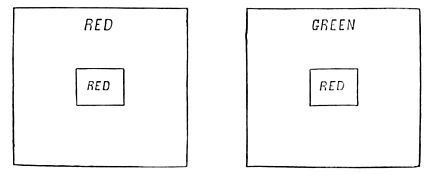squares are really identical in hue. By a somewhat analogous proceeding we can cause a surface which properly has no color of its own, which is really gray, to appear tinted red, blue, green, etc. These changes, and others of a like character, are produced by what is called contrast, and are partly due to actual effects generated in the eye itself, and partly to fluctuations in the judgment of the observer. The subject of contrast is so important that it will be worth while to make a somewhat careful examination of the laws which govern it, and it will be well for the reader to repeat some of the simple experiments described below. If we place a small piece of bright-green paper on a sheet of gray drawing-paper, in the manner indicated in Fig. 2, and then for several seconds attentively look at the small cross in the centre of the green slip, we shall find, on suddenly removing it, that in its place a faint image of a rose-red color makes its appearance (see Fig. 3). This
 | ||
| Fig. 2.—Gray Paper with Green Slip. | Fig. 3.—Gray Paper with Rose-colored Image. | |
red image presently vanishes, and the gray paper resumes its natural appearance. The rose-red ghost which is thus developed has a color which is complementary to that which called it into existence, and this will also be the case if we employ little squares of other colors: red will give rise to a greenish-blue image, blue to a yellow, violet to a greenish-yellow, etc., the color of the image being always complementary to that which gave rise to it. Upon this account these images are called negative, since as far as the color goes they are just the reverse of the images which are first presented to the eye of the observer. They are also often spoken of, in older treatises on optics, as "the accidental colors." It is quite easy to explain their production with the aid of the theory of Young and Helmholtz. Let us take as an example the experiment just described: According to our theory the green light from the little squares of paper, acting on the eye, fatigues to some extent the green nerves of the retina, the red and violet nerves meanwhile not being much affected. When the green paper is suddenly jerked away by the string, gray light is presented to the fatigued retina, and this gray light may be considered to consist, as far as we are concerned, of red, green, and violet light. The red and violet nerves, not being fatigued, respond powerfully to this stimulus; the green nerves, however, answer this new call on them more feebly, and in consequence
